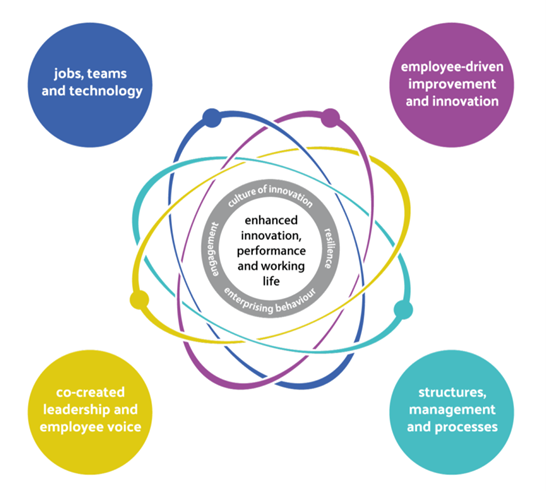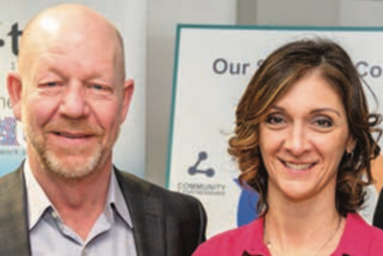Barry Leavitt, Rosana Kemsley, and Victoria Abboud
We are in the concluding stages of our research project on Workplace Innovation and Quality of Work, undertaken with in collaboration with numerous workplace partners across Canada with the support of the Government of Canada’s Future Skills Centre. You can find background info and interim results in the project blog posts, and we will be posting over the next few months on the Results, Implications and Future Directions.
The project plan was to share with workplace partners curated Research-to-Practice insights on Workplace Innovation and Quality of Work, and to have them create scenarios about how their organization could apply those insights to enhance their employee-led workplace innovation. Two workplace partners went further and have implemented those scenarios; in this post we’ll be sharing highlights from one of those success stories.
Organizational Context
ENWIN is a municipally-owned and operated energy and water services organization that serves the greater Windsor region in southwestern Ontario. Part of the organization’s vision is “to be a trusted leader in providing exceptional value and services to customers (90,000) and stakeholders” by engaging its 320 employees.
In 2018, ENWIN identified the desire to engage its employee base and build a culture that encourages, promotes, and values innovative problem-solving. Grassroots initiatives were supported and shared through the organization’s first “ENnovation Day.” Barry and Rosana were co-leaders of the ENnovation initiative.
By the next year, ENWIN partnered with WEtech Alliance, one of 17 Regional Innovation Centres in Ontario, to engage greater numbers of staff and subsequently established the “day” as an annual horizon. Known as ENnovation Catalyst, the pilot grass roots program encouraged employee sign-up to participate and to influence the strategic road map with their ideas. The participants were trained in Human-Centred Design Thinking and coached to frame their ideas for an innovation project into a “pitch” for the executive team. Over the next two years, 13 project proposals were developed by ENnovation participants, with 18 employees becoming “catalysts,” 50+ employees innvolved in Ideation Days and 26 additional employees “oriented” to innovation and design thinking.
As an example of an organization that had already begun its workplace innovation journey, the additional research insights and potential adaptations that the project team shared with ENWIN provided a lens for more critical reflection on the innovation initiatives that the organization had employed. For example, The Fifth Element model shown in Figure 1 below [from work by our project team member Peter Totterdill and colleague Rosemary Exton] highlights several issues in organizational capability – such as Job Design, Employee Voice, and Processes and Policies – to support employee-led workplace innovation, as well as the need for integrative thinking to align innovation planning across all of these (i.e., the Fifth Element). By viewing ENWIN’s mix of innovation and related HR programs through a Fifth Element lens, Barry and Rosana saw an opportunity to integrate an existing “Stretch Goals” process into the ENnovation process.
Fig. 1 The Fifth Element (of Organizational Capability for Workplace Innovation)
Rosana and Barry were able to adapt the Ennovation program processes to align with the three processes ENWIN had been using in its Stretch Goals program for head office employees: Build the Tools, Make It Better, and Move the Needle. (You can see another integrated sequence of innovation activities for a different workplace partner context in this blog post.)
For example, to enable today’s work while also preparing for tomorrow, job (or personal) development is a potential Build the Tools step that employees can initiate. HR and the employee’s manager support, facilitate, and coordinate the opportunity. Some of these opportunities are within the Ennovation process, e.g., iIndividuals can participate in an enabling committee to focus on Ideation Day, on the Process Improvement (PI) Council, in S’Well (ENWIN’s Social and Wellness Committee), and other opportunities to support innovative culture in the organization.
To inject new business change, the ENWIN team encourages employees to identify a Make It Better area of interest to move through process-improvement milestones in an innovation project.. Departments may create a structured roadmap to improve their business operations by using process-improvement methods, Design Thinking steps, etc. or they may select from the unionized employee suggestion program and partner with the “suggester” to move the idea through the innovation evaluation and implementation process.
Employees who choose to Move the Needle focus on supporting organizational strategic projects. They may engage with a strategic corporate goal as their own goal, or they may take on incremental work to support a colleague who is dedicated to a strategic corporate project.
The ENWIN Innovation leaders also expressed interest in exploring the adaptation of the Workplace Innovation Diagnostic® tool for their Canadian context. The Diagnostic is a distillation of research work from the European Union Workplace Innovation Network, which provides an evidence-based understanding of organizational capability for workplace innovation to enhance business performance and employee wellbeing. ENWIN’s innovation leaders have requested that members of our research team revisit this possibility later in 2023.
Results & Lessons Learned
In November 2022, Rosana and Barry pitched this Scenario to their C-suite executive team and received executive approval for implementation. Afterwards, they commented:
“We had a successful pitch and full executive endorsement to move forward with our proposal earlier this week. The roll-out has started and we’re already fielding inquiries from the rank and file with more to come over the next few weeks. We also have to curate some of our Innovation Catalyst material and streamline for this process that will fully kick off in January [2023]. We probably won’t know until sometime in early January how many ‘warriors’ we have after the business carves out resources for the existing priorities, but we suspect it will be a healthy cohort.”
“ENWIN has learned that buy-in is vital. Leadership must support and reinforce the investment of time, resources, and money. Those staff members who are enthusiastic must be encouraged to lead. They must have the time to learn and grow, be open-minded, and approach challenges with a beginner’s mindset.”
“Psychological safety is a key pillar in building a culture of innovation. More specifically, the culture must welcome new ideas, encourage divergent opinions, and be willing to empower team members at all levels and with all outcomes; i.e., failure and surprises must be applauded.”
About the authors
Barry Leavitt & Rosana Kemsley
Barry is Director of Corporate Operations & Innovation and Rosana is Manager of HR Services at ENWIN (Windsor ON)
Victoria Abboud
Vicki is a writer, educator & WINCan researcher.
(with project support from Thomas Carey, Adam Frye & Peter Totterdill)
Acknowledgement: Our project on Workplace Innovation and Quality of Work Life is supported by the Government of Canada’s Future Skills program



